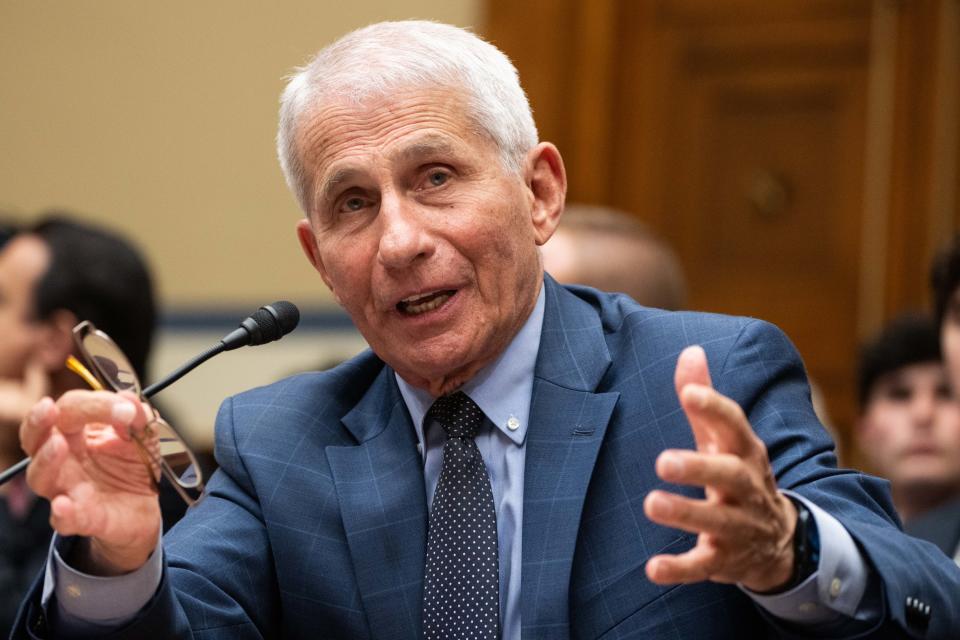COVID taught us a lot for future pandemics. Attacking Fauci doesn't make us safer.
In the early days of a pandemic, what we don’t know about a disease usually far outstrips what we do know. That’s the nature of new diseases – by definition, we don’t know much about them.
And there are usually a set of predictable questions – How does the virus spread? How dangerous is it? How can people protect themselves? Before we have answers to those questions, scientific experts are asked for guidance on what should be done. Typically, experts turn to what they do know from other similar viruses.
That was the story of the nation’s early response to COVID-19. When we knew very little about how the virus spread, scientists at the Centers for Disease Control and Prevention turned to what we did know about the spread of another respiratory pathogen: influenza or the flu. The CDC’s assessment has been, for decades, that flu spreads primarily through droplets – little bits of spit released when we speak or cough. Most of those droplets, based on CDC’s assessments, fall to the ground within about 3 feet of the infected person and certainly by 6 feet. This gave rise to what became a much maligned 6-feet rule in the early days of the pandemic.
The idea that a 6-feet rule could reduce the spread of COVID-19 was back in the news recently when Dr. Anthony Fauci, former head of the National Institute of Allergy and Infectious Diseases and adviser to seven U.S. presidents, testified before the House Subcommittee on the Coronavirus Pandemic.
Fauci's testimony shares new details: COVID guidelines caused millions to suffer. Now Fauci admits 'there was no science behind it.'
The 6-feet rule was a reasonable initial response to COVID-19 by the CDC based on scientists' understanding of how the flu spreads.
The 6-foot rule, explained in the CDC’s July 2020 “Social Distancing” information sheet, suggests that social distancing should be practiced to protect the spread of infection through coughs, sneezes or other methods of transmitting droplets from an infected person’s mouth or nose.
Social distancing wasn't invented by Fauci

Even the idea of social distancing wasn’t new. Under the Bush administration, planning in 2007 for future outbreaks, social distancing was identified as a key tool for use early in a pandemic while vaccines and treatments were being developed.
And while social distancing has come under fire, there is clear empirical evidence that early action on social distancing saved many, many lives.
Preventing the next COVID-19 pandemic: World desperately needs a pandemic agreement. Will we come together to save lives?
While it makes some sense to use flu as the model for transmission in the early days of the COVID-19 pandemic, the key is to update information and guidance as quickly as possible with new knowledge on the virus you face. In any fast moving pandemic, decisions must be based on the best information available and updated with new scientific studies as quickly as possible. Then that information must be communicated to the public in a transparent way about what we know, what we don’t know, how we plan to find out, and so forth.
It turned out that the droplet model of transmission for COVID was wrong (and it may even be wrong for the flu – but that’s another matter).
We learned COVID-19 largely spreads through aerosols – tiny particles that can linger in the air for long periods of time and can travel distances much greater than 6 feet. A person across a poorly ventilated room can still get infected. Maintaining physical distance still reduces your risk from aerosols, but it is insufficient to fully protect against the spread of infection. This is why guidance around masking and indoor air quality are important.
The CDC's COVID-19 response wasn't perfect
That dynamic nature of science – where you learn new things and pivot guidance based on that new knowledge – is where our country did less well. When we saw more than 50 people get infected with COVID-19 at a choir practice in Washington state in March 2020, it was the first strong signal that COVID-19 was being spread by aerosols. But many months later, CDC was still recommending 6-feet distancing despite growing evidence that it was likely not enough.
And the CDC recommendations of 6-feet distancing made it much harder to reopen schools and businesses, which had its own substantial costs.
Opinion alerts: Get columns from your favorite columnists + expert analysis on top issues, delivered straight to your device through the USA TODAY app. Don't have the app? Download it for free from your app store.
In these recent hearings, members of Congress unfairly attacked Dr. Fauci for the failures of the CDC and the Trump administration during the COVID-19 pandemic. Dr. Fauci was internally pushing for better data, but as the director of the National Institute of Allergies and Infectious Diseases, he could not openly contradict either the CDC or the administration.
There is no question that a switch to a new model of thinking about spread, that focused less on 6 feet and more on masking and clean air, would have been better at saving lives and allowing schools and businesses to reopen safely.
A retrospective look at what went wrong and how to do better is important. And while baseless attacks on Dr. Fauci may be comforting to some, it doesn’t get to the heart of the issues – and certainly doesn’t make our country better prepared for the future pandemics and other health challenges.
We must instead learn how to do better science faster. If we do, we will get better at responding to outbreaks while not imposing the large costs that society had to bear because so much of our guidance was based on outdated information.

Dr. Ashish K. Jha, MD, MPH, is the dean of the Brown University School of Public Health and a former White House COVID-19 response coordinator.
You can read diverse opinions from our USA TODAY columnists and other writers on the Opinion front page, on X, formerly Twitter, @usatodayopinion and in our Opinion newsletter.
This article originally appeared on USA TODAY: COVID taught us a lot for future pandemics. Attacking Fauci doesn't


